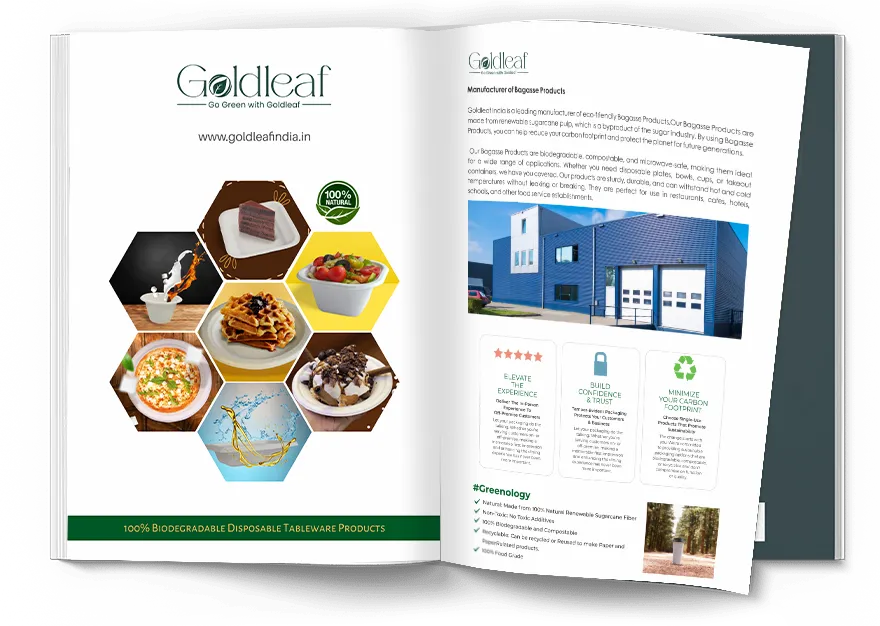تواصل مع فريقنا
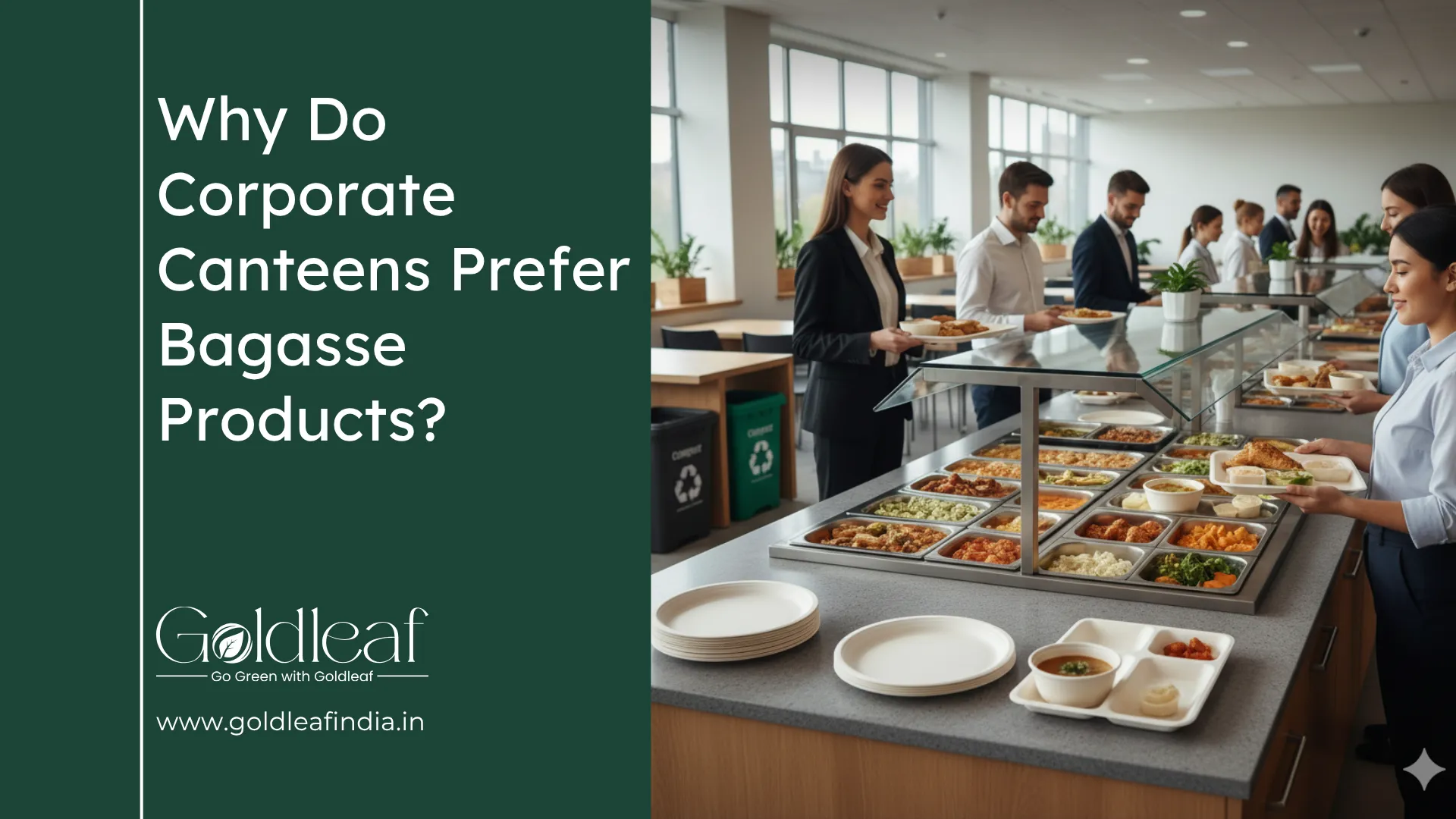
- 426
Corporate canteens are always looking for ways to be more sustainable, and you've probably noticed a big change in the types of containers your lunch comes in. Gone are many of the old plastic and foam boxes, replaced by newer, earth-friendlier options. One material you're seeing a lot more of is bagasse. But why is this stuff suddenly everywhere? It turns out, bagasse products aren't just a trend; they offer some pretty solid advantages for both the environment and the businesses that use them. Let's break down why so many companies are making the switch.
Key Takeaways
• Bagasse products come from sugarcane waste, making them a renewable resource that helps reduce reliance on trees and lowers carbon emissions compared to plastics.
• These containers perform well with hot food, resist grease and liquids, and are built to last, offering a reliable alternative to traditional packaging.
• Made from natural plant fibers, bagasse is non-toxic, free from harmful chemicals like PFAS, and helps keep food tasting like it should.
• Switching to bagasse can be cost-effective, especially with bulk buying, and it really helps boost a company's image as environmentally conscious.
• With increasing global regulations against single-use plastics and growing consumer demand for eco-friendly options, bagasse is well-positioned for future growth in the catering industry.
Environmental Benefits Of Bagasse Products
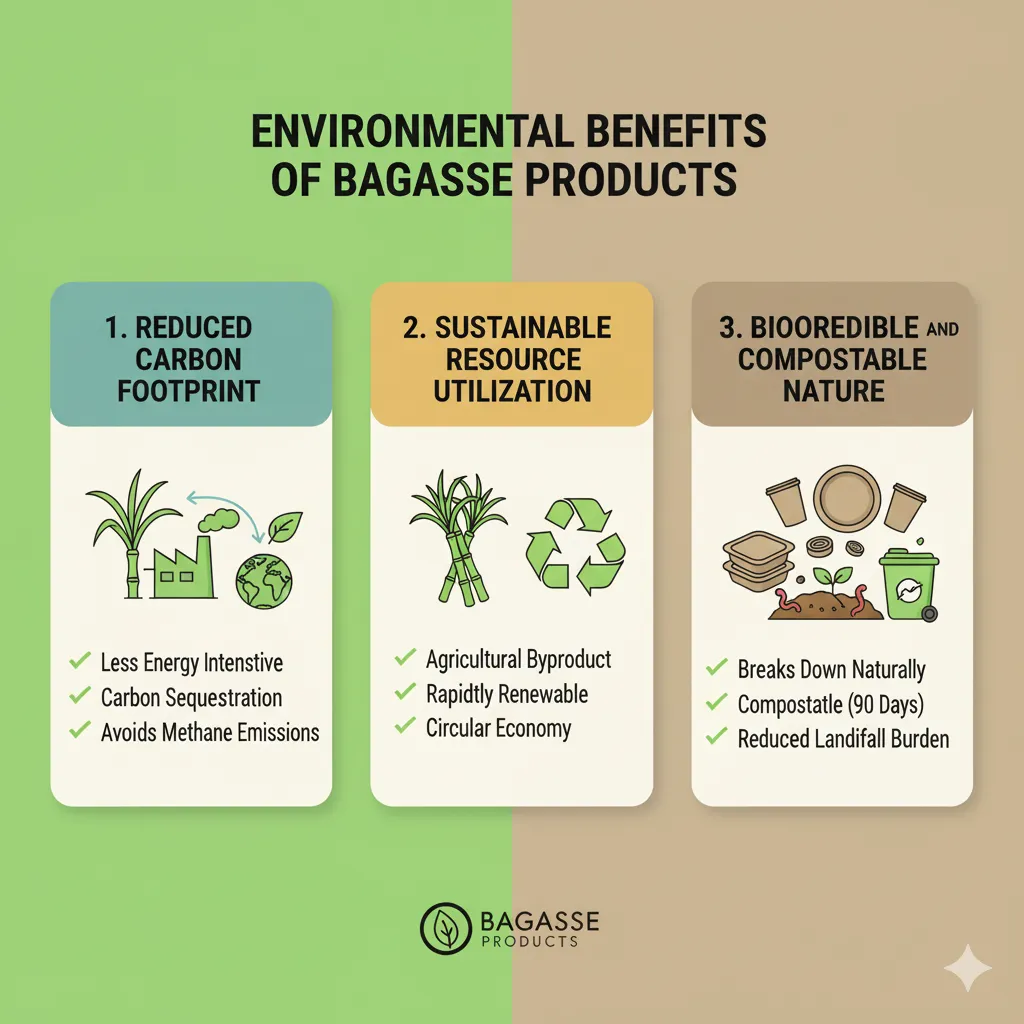
When you're running a corporate canteen or an office cafeteria, you're not just thinking about feeding people. You're also thinking about the planet, right? That's where bagasse products really shine. They're made from bagasse, which is basically the leftover pulp from sugarcane after the juice has been extracted. Instead of just throwing it away, it gets turned into useful stuff like bagasse food containers, bagasse plates, and even bagasse cutlery. It’s a smart way to use a resource that would otherwise be waste.
Reduced Carbon Footprint
Using bagasse for your disposable product needs significantly cuts down on the carbon emissions associated with manufacturing. Unlike plastics, which rely on fossil fuels, bagasse comes from a plant. The production process for bagasse items generally has a much lower carbon impact compared to traditional plastic packaging. This helps companies meet their sustainability goals and contributes to global efforts to reduce greenhouse gases. It’s a simple switch that makes a real difference in the overall environmental footprint of your office canteen.
Sustainable Resource Utilization
Think about it: sugarcane is a renewable crop. Every year, more sugarcane is grown, and the industry produces a massive amount of bagasse. By using bagasse containers and sugarcane plates, businesses are essentially giving this agricultural by-product a second life. This means less reliance on virgin materials and fewer trees being cut down for paper products. It’s a circular approach that’s good for the environment and supports agricultural economies. This practice is becoming increasingly important for any cafeteria in an office building looking to be more eco-conscious.
Biodegradable and Compostable Nature
One of the biggest wins for bagasse is its end-of-life story. Unlike plastic, which can stick around for hundreds of years, bagasse products are biodegradable and compostable. This means that after use, they can break down naturally, turning back into organic matter. Ideally, they break down in industrial composting facilities, often within a few months, leaving behind no harmful residues. This is a huge advantage over conventional disposable products, reducing landfill waste and preventing pollution. It’s a key reason why many are choosing bagasse food packaging from trusted manufacturer and suppliers like Goldleaf for their operations.
Here’s a quick look at why this matters:
• Less Landfill Waste: Bagasse items decompose, unlike plastics that persist for ages.
• Resource Efficiency: Utilizes a by-product of the sugar industry, reducing waste.
• Lower Environmental Impact: Manufacturing generally produces fewer emissions than plastic alternatives.
Choosing bagasse plates, bagasse bowls, sugarcane containers, or other items from Goldleaf is a clear signal that your office cafeteria cares about sustainability. It’s a simple yet effective way to make a positive environmental impact with every meal served. Many businesses are finding that this aligns perfectly with their efforts.
Superior Performance Of Bagasse Products
When you're running a busy canteen, you need tableware that can keep up. Plastic and foam containers sometimes buckle under pressure, literally. They can warp when they're hot, leak when they're greasy, and generally just don't hold up as well as you'd hope. That's where bagasse really shines.
Exceptional Heat Resistance
Bagasse containers are surprisingly good with heat. Using bagasse clamshell containers for takeaway meals in your cafeteria in office building simplifies handling greasy or saucy foods, reduces spills, and maintains hygiene. You can load them up with piping hot meals, or even pop them in the microwave for a quick reheat, and they won't get all floppy or start to break down. This means fewer complaints about lukewarm food or containers that can't handle the heat.
Grease and Liquid Integrity
Got a saucy curry or some crispy, oily fries? No problem for bagasse. Its natural fiber structure does a great job of keeping grease and liquids contained. Unlike some other disposable options that can get soggy or leak through, bagasse holds its own, keeping the food inside and your serving trays clean.
Structural Durability
These aren't flimsy things. Bagasse products are molded to be sturdy. They can handle being stacked, jostled during transport, or just generally handled throughout a busy service. This means you're less likely to have spills or messes caused by containers collapsing.
Health And Safety Advantages
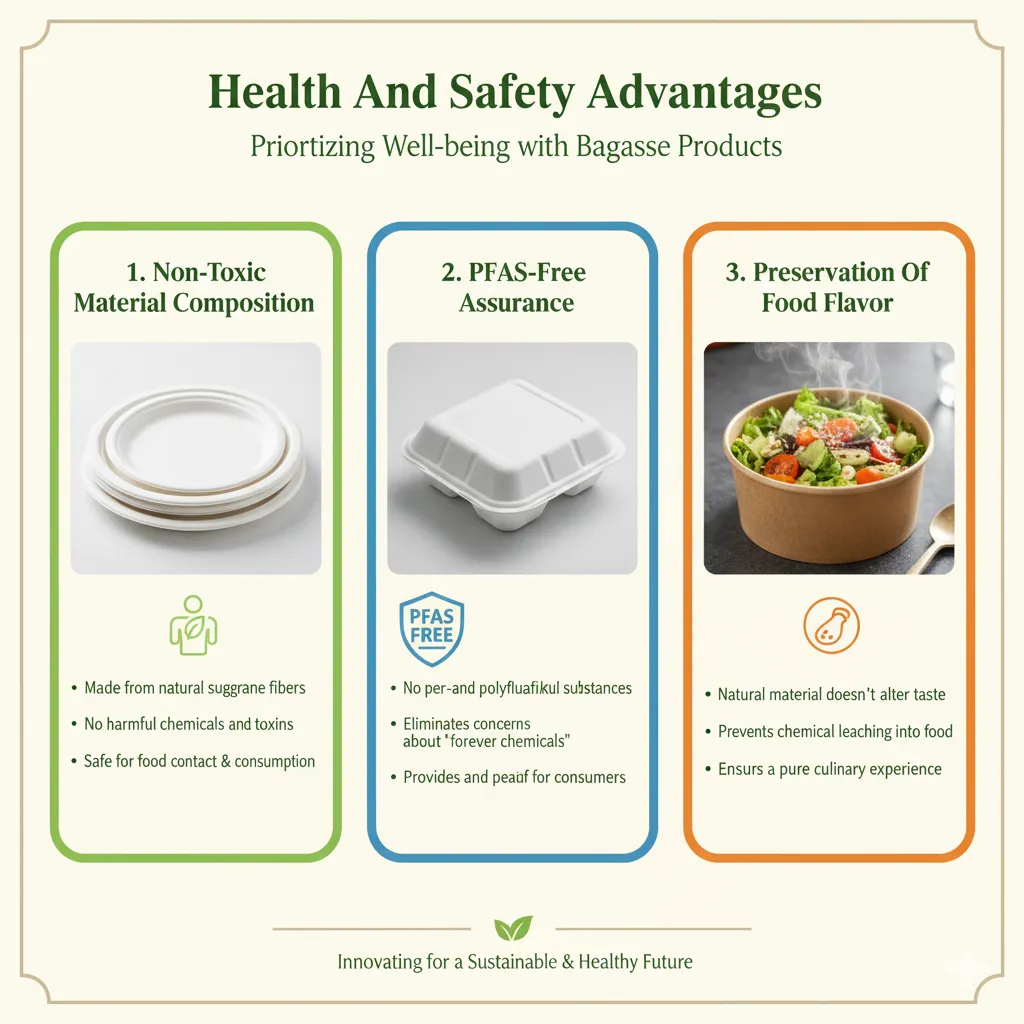
When you're thinking about what to serve food in at the company canteen, health and safety are pretty big deals. You don't want anything leaching into the food, right? That's where bagasse really shines. It's made from sugarcane fibers, which means it's a natural material. This makes it a much safer choice compared to some plastics that can contain questionable chemicals.
Non-Toxic Material Composition
Bagasse itself is pretty straightforward. It's plant-based, so you're not dealing with synthetic compounds that might break down when heated or come into contact with oily foods. This natural composition means you can feel more confident about what's touching your employees' meals. It's a simple, honest material.
PFAS-Free Assurance
This is a big one. You might have heard about PFAS chemicals, sometimes called 'forever chemicals.' They've been in the news a lot because they don't break down easily and can stick around in the environment and our bodies. Many traditional food containers, especially those designed to resist grease and moisture, might use PFAS. Bagasse products, however, are typically manufactured without these chemicals. This gives you peace of mind, knowing that the containers are free from these potentially harmful substances. It’s a key reason why many businesses are looking at sugarcane bagasse trays as a replacement for older packaging.
Preservation Of Food Flavor
Sometimes, packaging can impart its own taste or smell onto food, which isn't ideal. Bagasse, being a natural fiber, generally doesn't have this issue. It's pretty neutral, meaning it lets the actual flavor of the food come through. This can make a noticeable difference in the dining experience for employees. It’s a small detail, but it contributes to a better overall meal.
Economic And Market Appeal
When you're running a canteen, you've got to think about more than just the food. You need to consider how you present it, how much it costs, and what people actually want. This is where bagasse products really start to shine, making them a smart choice for businesses today.
Cost Competitiveness
It might surprise some people, but bagasse packaging is actually becoming quite affordable. As the technology to make these products gets better and more companies start using them, the prices have come down a lot. Compared to some other disposable options, especially those made from plastics that are getting more and more regulated, bagasse offers a really good balance of price and quality. This makes it easier for canteens to manage their budgets without sacrificing the quality or eco-friendliness of their packaging.
Enhanced Brand Image
Let's be honest, people care about the environment these days. When a canteen uses bagasse, it sends a clear message that the business is thinking about sustainability. This can really make a company look good in the eyes of its customers and employees. It shows you're a forward-thinking organization that's doing its part. It’s not just about being green; it’s about building a positive reputation.
Growing Consumer Demand
More and more, people are looking for businesses that align with their values. They want to support companies that are making an effort to be eco-friendly. This means that canteens offering bagasse products are likely to attract and keep customers who prioritize sustainability. It’s a simple way to meet a growing demand and stand out from the crowd. Think about it: if you had two similar lunch options, but one used eco-friendly sugar cane packaging and the other didn't, which one would you lean towards?
| Product Type | Typical Cost (vs. Plastic) | Environmental Impact | Consumer Perception |
|---|---|---|---|
| Bagasse Plates | Similar to mid-range plastic | Low | Positive |
| Plastic Plates | Varies widely | High | Mixed to Negative |
| Styrofoam Plates | Low | Very High | Negative |
Regulatory Compliance And Future Trends
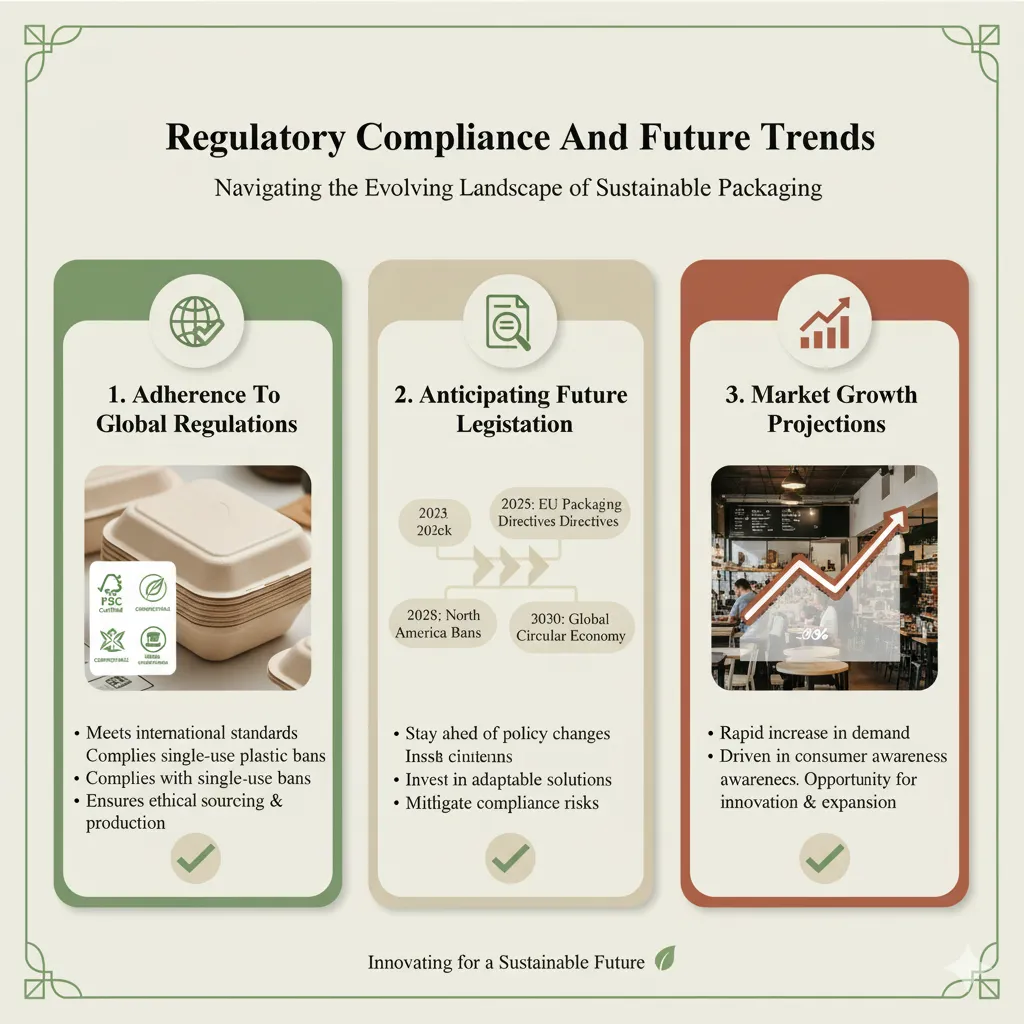
It’s getting pretty serious out there when it comes to packaging rules. Companies are really starting to pay attention, and for good reason. Staying ahead of these regulations isn't just about avoiding fines; it's about being a responsible business. Many places are cracking down on single-use plastics, and that means the shift to materials like bagasse is becoming less of a choice and more of a necessity. Think about it: if your current packaging isn't up to snuff, you could be looking at some hefty penalties or even being told you can't use it anymore. This is why understanding the certifications, like EN13432 for Europe or ASTM D6400 in the US, is super important. These aren't just fancy acronyms; they're proof that the products will actually break down as promised.
Adherence To Global Regulations
Across the globe, governments are implementing stricter rules for food packaging. For instance, by early 2025, Canada's SOR/2022-138 regulation will ban non-certified plastic food containers. Similarly, the EU's Single-Use Plastics Directive is fully enforced in 2025, requiring packaging to meet specific compostability criteria. Even at the state level in the US, California's SB 54 aims for all packaging to be recyclable or compostable by 2032, with initial steps starting in 2025. In Asia, countries like India are banning certain single-use plastics, and Singapore's packaging laws from 2025 will require sustainability reporting for larger food and beverage operators. This means that using compliant packaging, such as bagasse clamshells, is becoming essential for businesses to continue operating legally.
Anticipating Future Legislation
Looking ahead, the trend is clear: expect even more focus on waste reduction and circular economy principles. We're likely to see expanded Extended Producer Responsibility (EPR) schemes, which make manufacturers more accountable for the end-of-life management of their products. This could translate into higher costs for non-eco-friendly packaging. There's also a growing interest in 'smart' packaging that can track its origin and disposal, aiding in better waste management and recycling. Companies that proactively adopt sustainable packaging now will be better positioned to adapt to these future legislative changes, avoiding costly disruptions. It’s about getting ahead of the curve, not just reacting to it. For example, some businesses are already looking at hybrid systems that combine reusable and compostable elements to further cut down on waste.
Market Growth Projections
The market for compostable foodservice packaging is set for significant growth. Projections indicate the global market could reach USD 34.5 billion by 2030, with a compound annual growth rate of about 6.7%. This surge is largely driven by corporate environmental, social, and governance (ESG) procurement mandates and increasing consumer demand for sustainable options. We're seeing a noticeable rise in employee preference for eco-packaged lunches, with surveys showing a strong majority favoring them. This shift isn't just about environmental consciousness; it's also about brand image and attracting talent. Companies that embrace bagasse and other compostable materials are likely to see a positive impact on their brand perception and customer loyalty. It's a smart business move that aligns with both planetary health and profit.
Operational Advantages For Canteens
Switching to bagasse products isn't just about being green; it makes practical sense for canteen operations. Think about it: less hassle with waste, happier staff, and a better look for the company. It’s a win-win across the board. Using bagasse clamshell containers for takeaway meals in your cafeteria in office building simplifies handling greasy or saucy foods, reduces spills, and maintains hygiene.
Reduced Waste Management Costs
One of the biggest headaches for any canteen manager is dealing with trash. Traditional plastic and foam containers pile up fast, leading to higher disposal fees. Bagasse, being compostable, significantly cuts down the volume of waste sent to landfills. This means fewer pickups, lower hauling charges, and a cleaner back-of-house. Plus, setting up a composting system, even a simple one, can further reduce costs and turn waste into a resource. It’s a smart move that directly impacts the bottom line.
Improved Employee Satisfaction
People notice the little things, and the quality of their lunch experience matters. When employees see that their workplace cares enough to use eco-friendly and sturdy containers, it makes a difference. Bagasse products feel more substantial and look more appealing than flimsy plastic. They hold up well with hot or cold foods, and they don't feel cheap. This attention to detail contributes to a more positive overall dining experience, which can boost morale. A happy employee is often a more productive employee, and providing good quality, sustainable lunchware is a simple way to show you care.
Positive Employer Branding
In today's world, a company's image is everything, and that includes its commitment to sustainability. Using bagasse products in the canteen sends a clear message to employees, visitors, and the public that the company is environmentally conscious. This can be a real draw for talent, especially for younger generations who prioritize working for companies with strong ethical values. It’s a visible, everyday demonstration of corporate responsibility that can be shared on social media and in company reports, strengthening the brand's reputation. It shows you're not just talking about sustainability; you're living it. You can find great eco-friendly bagasse trays that fit this purpose perfectly.
Shop Eco-Friendly Bagasse Items
The Takeaway: Why Bagasse is the Future of Canteen Dining
So, it's pretty clear why corporate canteens are making the switch to bagasse. It's not just about looking good or following trends; it's about making a smart choice that benefits everyone. These sugarcane-based containers are tough enough for hot, greasy meals, safe for reheating, and they break down naturally, unlike plastic that sticks around forever. Plus, using them helps companies meet their green goals and shows employees they actually care about the planet. As more places ban single-use plastics and people get more aware of their environmental impact, bagasse is really becoming the go-to option. It’s a simple change that makes a big difference, proving that even something as everyday as lunch can be part of a bigger, better plan for sustainability.
Frequently Asked Questions
1. Why are companies choosing bagasse containers over plastic ones?
Companies are switching to bagasse because it's much better for the environment. Unlike plastic, which stays around forever and pollutes, bagasse is made from sugarcane leftovers and can break down naturally. It also holds hot food well without getting flimsy or leaking, which plastic often does. Plus, it's seen as a healthier choice since it doesn't contain harmful chemicals.
2. Is bagasse packaging really good for the planet?
Yes, it's a big improvement! Bagasse comes from sugarcane waste, so we don't need to cut down more trees or use extra land to make it. When you're done with it, it can break down into compost in just a few months, which helps the soil. This is way better than plastic, which pollutes our oceans and land for hundreds of years.
3. Can I reheat food in bagasse containers?
Absolutely! Bagasse containers are great because they can handle hot food and even go into the microwave or oven without melting or changing shape. This makes them super convenient for busy kitchens and for customers who want to reheat their meals.
4. Does bagasse packaging cost more than plastic?
While bagasse might cost a little more upfront than the cheapest plastic options, the price difference is getting smaller, especially when you buy in larger amounts. Many businesses find that the benefits, like looking more eco-friendly and meeting new rules, make it worth the small extra cost. It's an investment in a better image and a healthier planet.
5. Are there any rules about using bagasse packaging?
Yes, many places are making rules about single-use plastics, and these rules often favor materials like bagasse. To be sure, look for bagasse products that have certifications like EN13432 or ASTM D6400. These show that the packaging meets international standards for being compostable and safe, which is important for staying on the right side of the law.
6. How does using bagasse help a company's image?
Using bagasse shows that a company cares about the environment and is trying to be more sustainable. This is really important to customers today, especially younger generations who want to support businesses that do good things. It makes the company look responsible and modern, and employees often feel proud to work for a place that makes eco-friendly choices.
- منتجات
- Bowl
- Clamshell
- Compartment Plate
- Plate
- Tea Cup
© 2024 , Goldleaf ,
جميع الحقوق محفوظة.
Made & Managed by Lightlink Solutions



